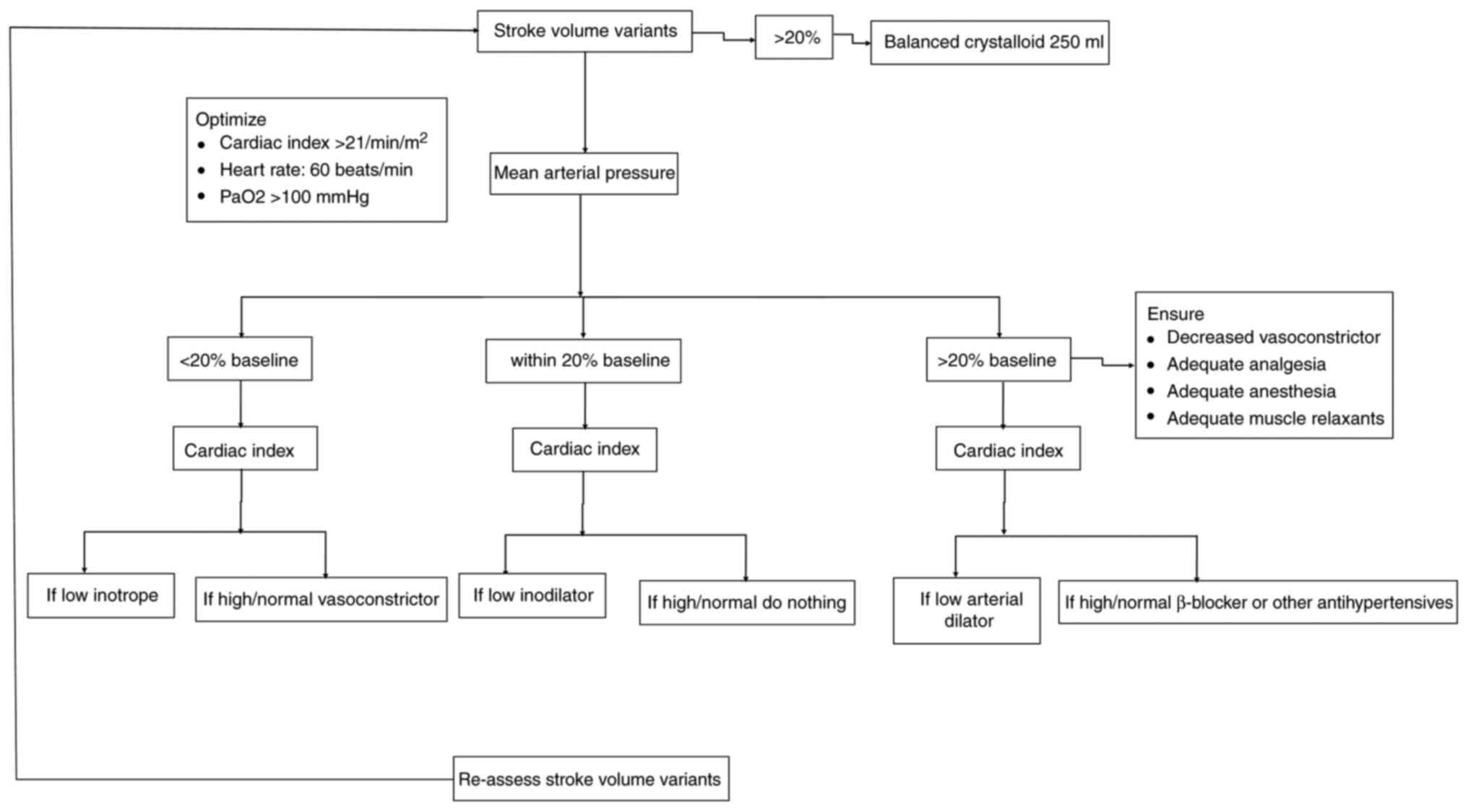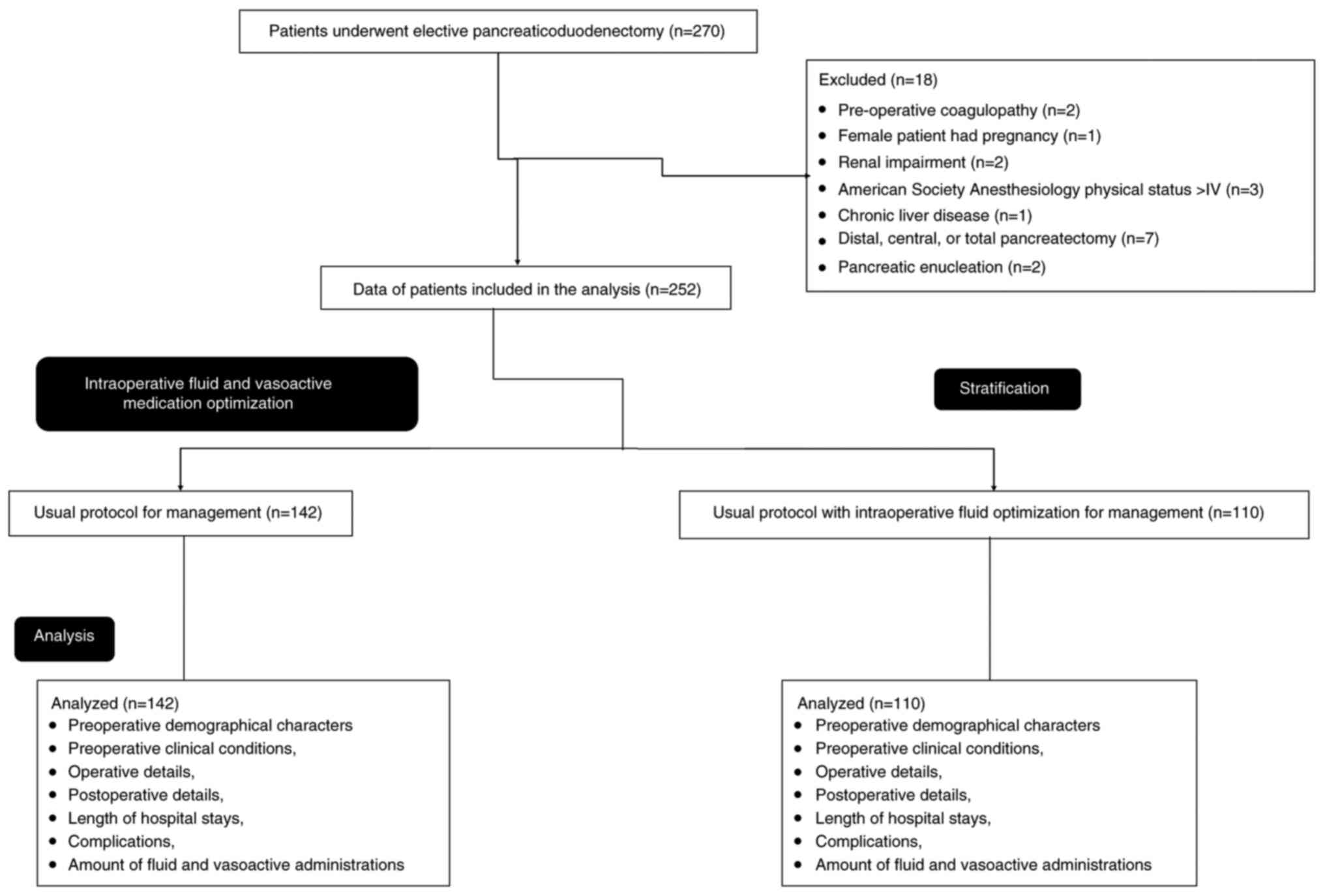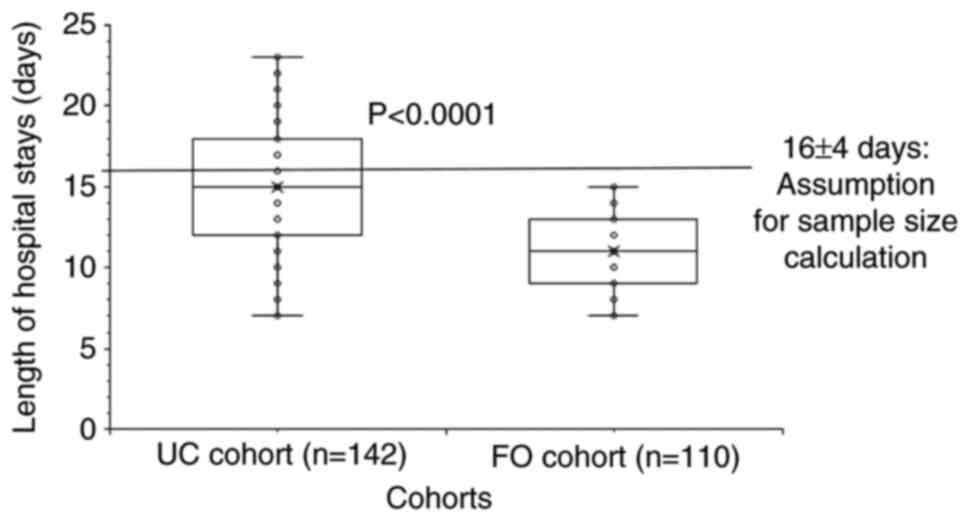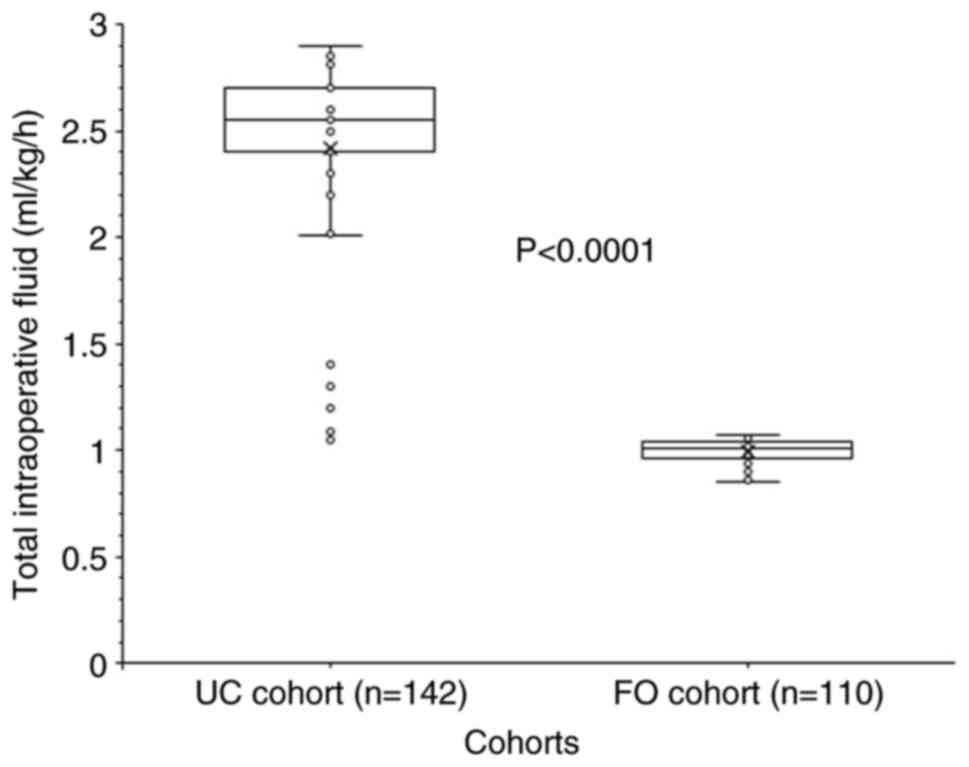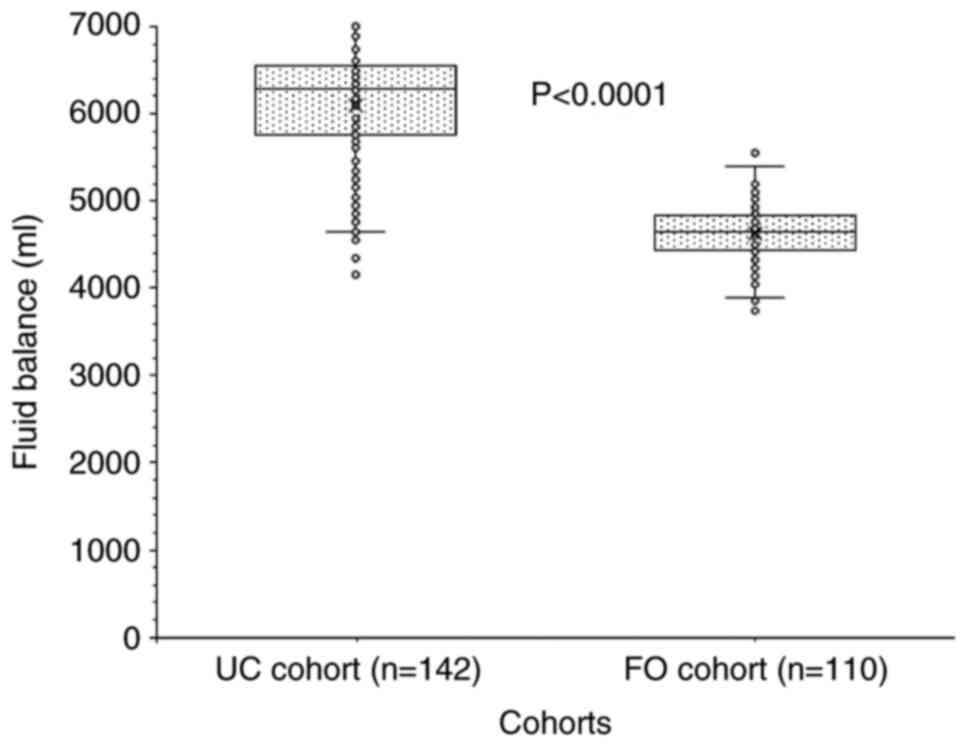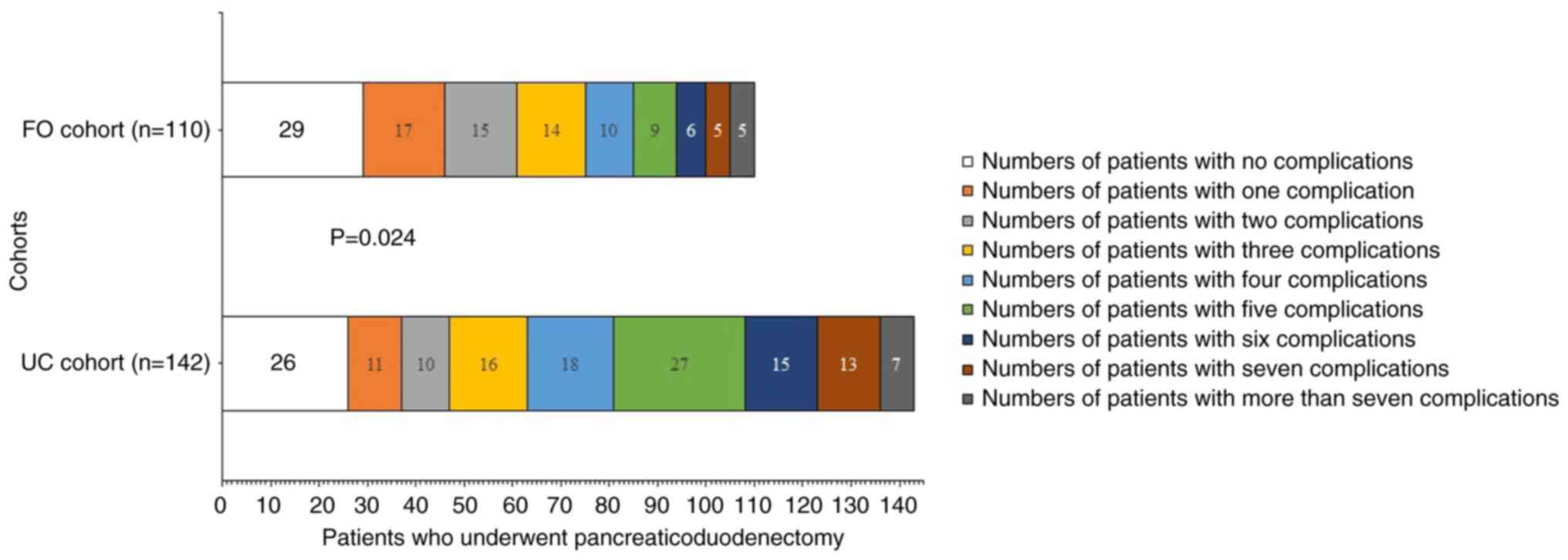|
1
|
Rahib L, Smith BD, Aizenberg R, Rosenzweig
AB, Fleshman JM and Matrisian LM: Projecting cancer incidence and
deaths to 2030: The unexpected burden of thyroid, liver and
pancreas cancers in the United States. Cancer Res. 74:2913–2921.
2014.PubMed/NCBI View Article : Google Scholar
|
|
2
|
Wright GP, Koehler TJ, Davis AT and Chung
MH: The drowning whipple: Perioperative fluid balance and outcomes
following pancreaticoduodenectomy. J Surg Oncol. 110:407–411.
2014.PubMed/NCBI View Article : Google Scholar
|
|
3
|
Weinberg L, Ianno D, Churilov L, Chao I,
Scurrah N, Rachbuch C, Banting J, Muralidharan V, Story D, Bellomo
R, et al: Restrictive intraoperative fluid optimisation algorithm
improves outcomes in patients undergoing pancreaticoduodenectomy: A
prospective multicentre randomized controlled trial. PLoS One.
12(e0183313)2017.PubMed/NCBI View Article : Google Scholar
|
|
4
|
Fellahi JL, Futier E, Vaisse C, Collange
O, Huet O, Loriau J, Gayat E, Tavernier B, Biais M, Asehnoune K, et
al: Perioperative hemodynamic optimization: From guidelines to
implementation-an experts' opinion paper. Ann Intensive Care.
11(58)2021.PubMed/NCBI View Article : Google Scholar
|
|
5
|
Weinberg L, Wong D, Karalapillai D, Pearce
B, Tan CO, Tay S, Christophi C, McNicol L and Nikfarjam M: The
impact of fluid intervention on complications and length of
hospital stay after pancreaticoduodenectomy (Whipple's procedure).
BMC Anesthesiol. 14:1–8. 2014.PubMed/NCBI View Article : Google Scholar
|
|
6
|
Behman R, Hanna S, Coburn N, Law C, Cyr
DP, Truong J, Lam-McCulloch J, McHardy P, Sawyer J, Idestrup C and
Karanicolas PJ: Impact of fluid resuscitation on major adverse
events following pancreaticoduodenectomy. Am J Surg. 210:896–903.
2015.PubMed/NCBI View Article : Google Scholar
|
|
7
|
Lassen K, Soop M, Nygren J, Cox PB, Hendry
PO, Spies C, von Meyenfeldt MF, Fearon KC, Revhaug A, Norderval S,
et al: Consensus review of optimal perioperative care in colorectal
surgery: Enhanced recovery after surgery (ERAS) group
recommendations. Arch Surg. 144:961–969. 2009.PubMed/NCBI View Article : Google Scholar
|
|
8
|
Kagedan DJ, Ahmed M, Devitt KS and Wei AC:
Enhanced recovery after pancreatic surgery: A systematic review of
the evidence. HPB. 17:11–16. 2015.PubMed/NCBI View Article : Google Scholar
|
|
9
|
Melloul E, Lassen K, Roulin D, Grass F,
Perinel J, Adham M, Wellge EB, Kunzler F, Besselink MG, Asbun H, et
al: Guidelines for perioperative care for pancreatoduodenectomy:
Enhanced recovery after surgery (ERAS) recommendations 2019. World
J Surg. 44:2056–2084. 2020.PubMed/NCBI View Article : Google Scholar
|
|
10
|
Gianotti L, Besselink MG, Sandini M,
Hackert T, Conlon K, Gerritsen A, Griffin O, Fingerhut A, Probst P,
Abu Hilal M, et al: Nutritional support and therapy in pancreatic
surgery: A position paper of the international study group on
pancreatic surgery (ISGPS). Surgery. 164:1035–1048. 2018.PubMed/NCBI View Article : Google Scholar
|
|
11
|
Wang HB, Xiong GB, Zhu F, Wang M, Zhang H,
Feng YC, Yu S, Jin JK and Qin RY: Clavien-Dindo classification and
influencing factors analysis of complications after laparoscopic
pancreaticoduodenectomy. Zhonghua Wai Ke Za Zhi. 56:828–832.
2018.PubMed/NCBI View Article : Google Scholar : (In Chinese).
|
|
12
|
Liver and Gastrointestinal Disease
Foundation: The Clavien-Dindo classification. https://www.assessurgery.com/clavien-dindo-classification/.
Accessed on 10 December 2020.
|
|
13
|
Dusch N, Lietzmann A, Barthels F,
Niedergethmann M, Rückert F and Wilhelm TJ: International study
group of pancreatic surgery definitions for postpancreatectomy
complications: Applicability at a high-volume center. Scand J Surg.
106:216–223. 2017.PubMed/NCBI View Article : Google Scholar
|
|
14
|
Jammer I, Wickboldt N, Sander M, Smith A,
Schultz MJ, Pelosi P, Leva B, Rhodes A, Hoeft A, Walder B, et al:
Standards for definitions and use of outcome measures for clinical
effectiveness research in perioperative medicine: European
perioperative clinical outcome (EPCO) definitions: a statement from
the ESA-ESICM joint taskforce on perioperative outcome measures.
Eur J Anaesthesiol. 32:88–105. 2015.PubMed/NCBI View Article : Google Scholar
|
|
15
|
Melis M, Marcon F, Masi A, Sarpel U,
Miller G, Moore H, Cohen S, Berman R, Pachter HL and Newman E:
Effect of intra-operative fluid volume on peri-operative outcomes
after pancreaticoduodenectomy for pancreatic adenocarcinoma. J Surg
Oncol. 105:81–84. 2012.PubMed/NCBI View Article : Google Scholar
|
|
16
|
Eng OS, Goswami J, Moore D, Chen C, Gannon
CJ, August DA and Carpizo DR: Intraoperative fluid administration
is associated with perioperative outcomes in
pancreaticoduodenectomy: A single center retrospective analysis. J
Surg Oncol. 108:242–247. 2013.PubMed/NCBI View Article : Google Scholar
|
|
17
|
Fischer M, Matsuo K, Gonen M, Grant F,
Dematteo RP, D'Angelica MI, Mascarenhas J, Brennan MF, Allen PJ,
Blumgart LH and Jarnagin WR: Relationship between intraoperative
fluid administration and perioperative outcome after
pancreaticoduodenectomy: Results of a prospective randomized trial
of acute normovolemic hemodilution compared with standard
intraoperative management. Ann Surg. 252:952–958. 2010.PubMed/NCBI View Article : Google Scholar
|
|
18
|
Lassen K, Coolsen MM, Slim K, Carli F, de
Aguilar-Nascimento JE, Schäfer M, Parks RW, Fearon KC, Lobo DN,
Demartines N, et al: Guidelines for perioperative care for
pancreaticoduodenectomy: Enhanced recovery after surgery
(ERAS®) society recommendations. Clin Nutr. 31:817–830.
2012.PubMed/NCBI View Article : Google Scholar
|
|
19
|
Lassen K, Coolsen MM, Slim K, Carli F, de
Aguilar-Nascimento JE, Schäfer M, Parks RW, Fearon KC, Lobo DN,
Demartines N, et al: Guidelines for perioperative care for
pancreaticoduodenectomy: Enhanced recovery after surgery
(ERAS®) society recommendations. World J Surg.
37:240–258. 2013.PubMed/NCBI View Article : Google Scholar
|
|
20
|
Pearse RM, Harrison DA, MacDonald N,
Gillies MA, Blunt M, Ackland G, Grocott MP, Ahern A, Griggs K,
Scott R, et al: Effect of a perioperative, cardiac output-guided
hemodynamic therapy algorithm on outcomes following major
gastrointestinal surgery: A randomized clinical trial and
systematic review. JAMA. 311:2181–2190. 2014.PubMed/NCBI View Article : Google Scholar
|
|
21
|
Nikfarjam M, Weinberg L, Low N, Fink MA,
Muralidharan V, Houli N, Starkey G, Jones R and Christophi C: A
fast track recovery program significantly reduces hospital length
of stay following uncomplicated pancreaticoduodenectomy. JOP.
14:63–70. 2013.PubMed/NCBI View Article : Google Scholar
|
|
22
|
Vretzakis G, Kleitsaki A, Stamoulis K,
Bareka M, Georgopoulou S, Karanikolas M and Giannoukas A:
Intra-operative intravenous fluid restriction reduces perioperative
red blood cell transfusion in elective cardiac surgery, especially
in transfusion-prone patients: A prospective, randomized controlled
trial. J Cardiothorac Surg. 5:1–10. 2010.PubMed/NCBI View Article : Google Scholar
|
|
23
|
Cumberworth A and Cumberworth J:
Intraoperative fluids and postoperative haemoglobin. Br J Anaesth.
116(723)2016.PubMed/NCBI View Article : Google Scholar
|
|
24
|
Sutton JM, Kooby DA, Wilson GC, Squires MH
III, Hanseman DJ, Maithel SK, Bentrem DJ, Weber SM, Cho CS, Winslow
ER, et al: Perioperative blood transfusion is associated with
decreased survival in patients undergoing pancreaticoduodenectomy
for pancreatic adenocarcinoma: A multi-institutional study. J
Gastrointest Surg. 18:1575–1587. 2014.PubMed/NCBI View Article : Google Scholar
|
|
25
|
Navarro LH, Bloomstone JA, Auler JO Jr,
Cannesson M, Rocca GD, Gan TJ, Kinsky M, Magder S, Miller TE,
Mythen M, et al: Perioperative fluid therapy: A statement from the
international fluid optimization group. Perioper Med. 4:1–20.
2015.PubMed/NCBI View Article : Google Scholar
|
|
26
|
Li Y, Xiaozhu Z, Guomei R, Qiannan D and
Hahn RG: Effects of vasoactive drugs on crystalloid fluid kinetics
in septic sheep. PLoS One. 12(e0172361)2017.PubMed/NCBI View Article : Google Scholar
|
|
27
|
Li YH, Zhu HB, Zheng X, Chen HJ, Shao L
and Hahn RG: Low doses of esmolol and phenylephrine act as
diuretics during intravenous anesthesia. Crit Care.
16(R18)2012.PubMed/NCBI View
Article : Google Scholar
|
|
28
|
Weinberg L, Banting J, Churilov L, McLeod
RL, Fernandes K, Chao I, Ho T, Ianno D, Liang V, Muralidharan V, et
al: The effect of a surgery-specific cardiac output-guided
haemodynamic algorithm on outcomes in patients undergoing
pancreaticoduodenectomy in a high-volume centre: A retrospective
comparative study. Anaesth Intensive Care. 45:569–580.
2017.PubMed/NCBI View Article : Google Scholar
|
|
29
|
Vos JJ, Poterman M, Salm PP, Van Amsterdam
K, Struys MM, Scheeren TW and Kalmar AF: Noninvasive pulse pressure
variation and stroke volume variation to predict fluid
responsiveness at multiple thresholds: A prospective observational
study. Can J Anaesth. 62:1153–1160. 2015.PubMed/NCBI View Article : Google Scholar
|
|
30
|
Cannesson M, Le Manach Y, Hofer CK, Goarin
JP, Lehot JJ, Vallet B and Tavernier B: Assessing the diagnostic
accuracy of pulse pressure variations for the prediction of fluid
responsiveness: A ‘gray zone’ approach. Anesthesiology.
115:231–241. 2011.PubMed/NCBI View Article : Google Scholar
|
|
31
|
Ramsingh DS, Sanghvi C, Gamboa J,
Cannesson M and Applegate RL II: Outcome impact of goal directed
fluid therapy during high risk abdominal surgery in low to moderate
risk patients: A randomized controlled trial. J Clin Monit Comput.
27:249–257. 2013.PubMed/NCBI View Article : Google Scholar
|
|
32
|
Jammer I, Tuovila M and Ulvik A: Stroke
volume variation to guide fluid therapy: Is it suitable for
high-risk surgical patients? A terminated randomized controlled
trial. Perioper Med (Lond). 4(6)2015.PubMed/NCBI View Article : Google Scholar
|
|
33
|
Scheeren TW, Wiesenack C, Gerlach H and
Marx G: Goal-directed intraoperative fluid therapy guided by stroke
volume and its variation in high-risk surgical patients: A
prospective randomized multicentre study. J Clin Monit Comput.
27:225–233. 2013.PubMed/NCBI View Article : Google Scholar
|















